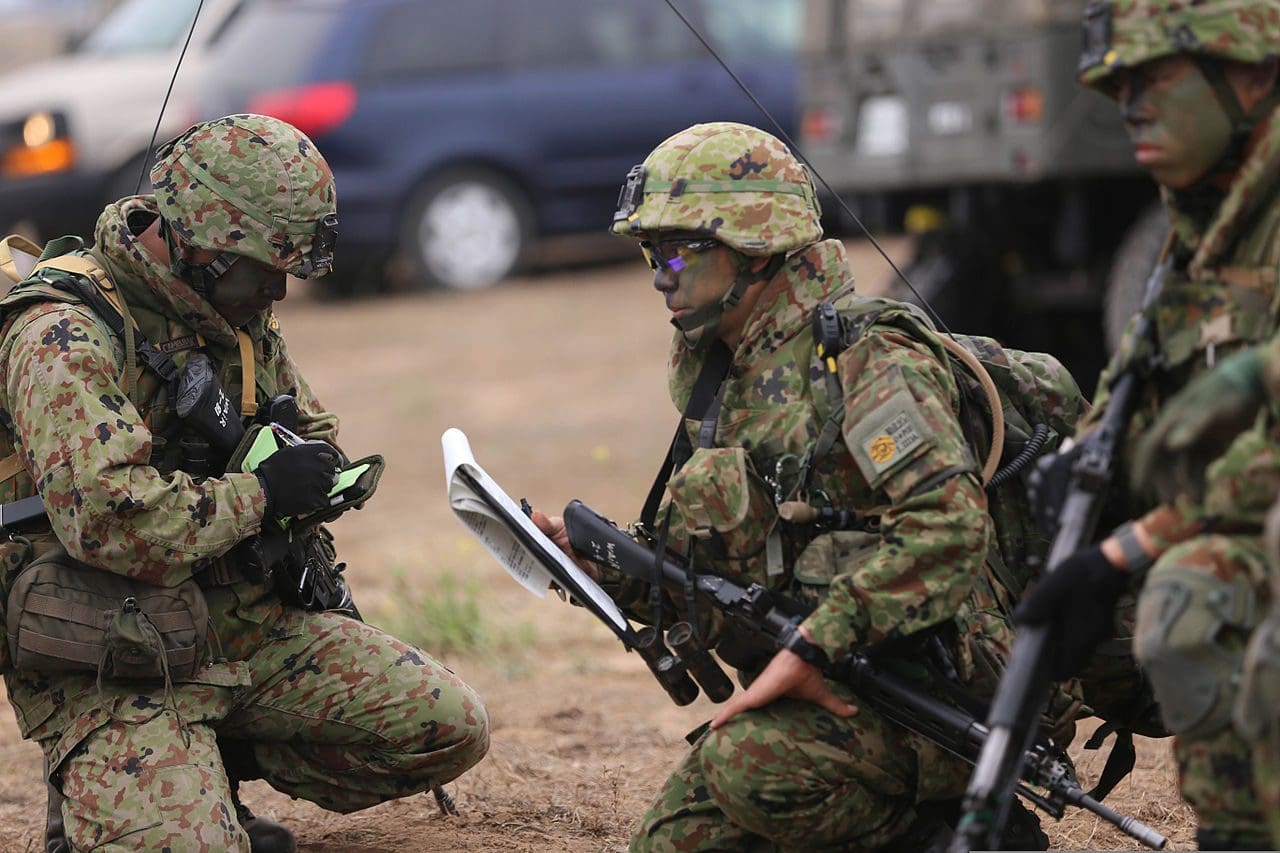Si vis pacem, para bellum—the old Latin adage by Publius Flavius has never been more to the point than now in the case of Japan, planning to underpin its defence-oriented security policy with an unprecedented boost to the country’s military spending.
Japan, whose pacifism is enshrined in its Constitution, revised its three main defence and national security documents after a decade and is set to increase its defence spending to NATO level, 2 per cent of GDP. Although some critics, mainly from countries threatening Japan’s sovereignty, have voiced fears about Japan turning its back on its decades-long pacifist posture or interpret the revised strategies as major shifts, the new defence guidelines are just the reflection of the global and regional security landscapes that have significantly changed for the worse during the last decade, and probably for the worst since the end of the world war.
In December, the Japanese cabinet revised the top three national security and defence policy documents of the country: the National Security Strategy, the National Defence Strategy, replacing the former National Defence Programme Guidelines, and the Medium-Term Defence Programme, now renamed to Defence Build-Up Programme. The trio of the most important national security documents was adopted on 16 December 2022—perhaps accidentally marking exactly the tenth anniversary of LDP’s landslide win that paved the way for the triumphant return of Abe Shinzo.
The revision of the defence and security strategies was long due, as they were drafted five and ten years ago respectively, under different circumstances both domestically and on the foreign security front.
The present national security architecture with the National Security Council was established only a decade ago, in 2013, on the initiative of the late prime minister, Abe Shinzo, who returned to power in late 2012 to shape Japan’s foreign and security policy in ways we had never seen before. The first national security strategy was also adopted in 2013, another landmark legacy of Abe’s almost eight-year long second tenure. Even the term ‘national security’ was revolutionary in a country which has the strictest restrictions when it comes to the military, defence, or national strategy. The first NSS pushed through by Abe officially replaced an old and very short document, the Basic Policy on National Defence from 1957. The new NSS makes a good attempt at defining Japan’s national interests, a debate and topic largely avoided in the past 77 years, since the defeat in WWII. The main pillar of Japan’s foreign and security policy, the Free and Open Indo-Pacific principle is reflected in the new document, which states that ‘Japan will maintain and develop a free and open international order, especially in the Indo-Pacific region where Japan is situated.’
The major breakthroughs in the new NSS are the inclusion of counterstrike capabilities, as a key element of defending the country; the creation of a joint military command structure with a permanent joint headquarters; and a robust defence spending going up to 43 trillion yen in five years, aiming to reach the NATO standard of 2 per cent of GDP, breaking the traditional, yet never written down, legally binding rule of 1 per cent, that has constrained Japan’s defence budget. The new acquisitions and defence build-up will include purchasing long range precision strike cruise missiles, to enable Japan to hit targets deep inside enemy territory, Tomahawk missiles, and the Aegis ashore missile defence system. It will further strengthen the Japan-US alliance and defence cooperation because an effective strike capability will require a much deeper integration with the US forces in intelligence sharing, reconnaissance, and targeting capabilities. According to CSIS, the upgraded Japanese defence capabilities will require a level of cooperation between the Japanese and US forces that we have never seen before. The new Japanese National Security Strategy is very much welcomed in Washington, and has earned prime minister Kishida his first official visit to the White House. At the meeting with President Biden scheduled for 13 January, ‘President Biden will reiterate his full support for Japan’s recently released National Security Strategy, its presidency of the G7, and its term as a non-permanent member of the United Nations Security Council,’ and ‘The leaders will celebrate the unprecedented strength of the U.S.-Japan Alliance and will set the course for their partnership in the year ahead,’ according to the statement released by the White House.
The new NSS reflects the reality of the dramatic worsening of security landscape around Japan and in the world during the past decade.
It is also the acknowledging of the fact that the balance of power has significantly shifted towards China, a country that has been going through a massive military build-up for decades in a non-transparent way.
Today the old joke about Japan’s foreign policy environment became true: the only peaceful and friendly relation in the neighbourhood is in the East with the Pacific Ocean. Looking West, Japan maintains the best relationship with the Republic of Korea, a fellow democracy with whom relations are not only multi-faceted, but also very troubled and burdened with historic issues going back to Japan’s occupation of the Korean peninsula between 1910 and 1945; and Taiwan, another former colony and working democracy in East Asia. The rest of its immediate neighbours, namely North Korea, Russia, and China, all pose a serious threat and strategic challenge to Japan.
North Korea, traditionally hostile towards Japan, had a record year in 2022 in ballistic missile tests, firing more rockets than ever before, and even testing a hypersonic missile. Until the end of the year, the DPRK launched more than 90 ballistic missiles, also setting a record of 23 a day. In October, for the first time, a North Korean missile flew over the territory of Japan. Meanwhile, the Hermit Communist Kingdom is said to be preparing for its seventh nuclear test.
The rhetoric about China has also shifted, more specifically, China is being named what it is: not only a matter of serious concern, but the greatest strategic challenge to Japan, the international community, and the rules-based global order. The language of the defence documents has earned the usual toughly-worded criticism from China, but, looking at the realities, what is surprising is how long the softer language was used despite China threatening Japan’s territorial sovereignty on a daily basis with its territorial claims over the Japan-held Senkaku islands and its regular intrusions into Japanese territorial waters. The tension growing around Taiwan and China’s articulate plans for a ‘reunification’ also raised alarms in Japan as policymakers well know that any Chinese attack on Taiwan would immediately drag Japan into the armed conflict due to the geographical vicinity, and the fact that the US troops meant to secure the safety of Taiwan are mostly based in Okinawa. It is also well known, and not only in Tokyo, that China’s aim is to extend its sphere of influence over the Pacific region where the first island chain with US- ally Japan is a clear strategic obstacle.
With its bloody invasion of Ukraine, Putin’s Russia proved in 2022 that physical violence and disrespect for international law and other countries’ sovereignty is an integral part of its foreign policy arsenal, and a major war suddenly became a reality. Let’s not forget that Russia has illegally occupied four groups of islands north of Hokkaido, called the Southern Kurils in Russia, which is the core reason there is still no official peace treaty between Japan and the Russian Federation since 1945. In light of all this, the language about Russia in the previous NSS looks rather naïve retrospectively, as Japan saw a potential partner in Russia to cooperate with in securing peace and stability in the region, at that time still called Asia-Pacific in official documents.
In 2022, however, there is no doubt in Tokyo that Russia is a military threat that is not afraid to use military force to further its strategic goals.
The counterstrike or enemy base strike capability is an important new element in the doctrine. But what should be a natural component in any other country’s national security, it can be viewed controversial in the case of Japan. The Constitution of Japan drafted in 1947 by the occupying US administration and adopted in 1948 has the toughest constitutional limits on defence and security policy in the world. Its famous Article 9 states that ‘the Japanese people forever renounce war as a sovereign right of the nation and the threat or use of force as means of settling international disputes‘ and thus ‘land, sea, and air forces, as well as other war potential, will never be maintained,‘ and ‘The right of belligerency of the state will not be recognized.‘ Literally, Japan can have no army and cannot possess any war potential. Officially, there has been no army in Japan since 1945. The Japanese military is called the Japanese Self-Defence Forces (JSDF). The constitutional check on the war potential got so severe that it soon became too much even for the original author United States, who urged Japan to rearm when the UN forces led by the United States got involved in the Korean war and needed help and support from Japan. According to the Constitution still in force without the slightest change ever since, Japan can have no war capabilities, yet if the massive defence spending plan gets realized, Japan will have the third largest defence force in the world by spending figures.
The key element here is the concept of ‘minimum extent necessary’, i.e., Japan continues to maintain a strictly defence-oriented policy. It means that in the event of an armed enemy attack, Japan is constrained to using force to the ‘minimum extent necessary’ to stave off such an attack. (For more on the concept of ‘minimum extent necessary’ see this compact analysis by KAS Japan.) The question is how Japan can save its land and people best if for example there is a missile attack? Wait until the enemy missile, armed with a conventional or nuclear warhead, reaches Japanese territory and while doing so, carry out a philosophical or legal debate if it constitutes an armed attack or not? Or debate what the minimum necessary response should be? Or just fire back immediately, targeting the origin of the attack against Japan to prevent more incoming missiles?
It is a clear sign of the worsened security landscape around Japan that ten years ago even the term collective self-defence was highly debated; this time, codification of the counterstrike capability and the robust defence spending enjoys the support of the majority of the Japanese public and there has been no debate, demonstration, no sign of a public backlash or any distorted narrative about the ‘militarization’ of Japan. Even LDP’s coalition partner Komeito, traditionally representing a peace platform, agreed to the new defence strategy documents. According to a fresh poll made by the rather left-leaning Asahi Shimbun immediately after the release of the new defence guidelines, a majority (56 per cent) of the public supported enemy base strike capabilities; the public was evenly divided about the robust defence spending; and naturally, two thirds of them were against partially financing all this by raising taxes.
The Achilles heel of the ambitious plans is how to finance the huge extra spending.
Japan has been running a huge government debt of over 240 per cent of its GDP and a budget deficit, where even the primary balance is out of visible reach. To make things worse, the BOJ just recently announced it no longer can maintain its yield curve management to keep the yields of the Japanese government bonds (JGB) at zero level, which will put further pressure on the budget through refinancing its debt. The answer is raising taxes to fill the gap. The main target of extra taxation is the corporate sector that has booked record earnings since the positive effects of Abenomics and has been hoarding cash ever since. The original idea of Abenomics that the lowering of the corporate tax would lead to higher wages, however, never worked.
But raising taxes is never a winning ticket in politics. There was backlash within the ruling LDP against the idea of funding the defence spending through extra tax revenues (the good old deficit spending by issuing more JGBs would have been preferred by many), even from big guns from the right wing of the party, like Takaichi Sanae or Nishimura Yasutoshi, generally in favour of a stronger and more assertive defence and security policy. The idea of a tax raise won’t help much the troubled prime minster, Kishida Fumio, whose support rate has been steadily decreasing since last summer and reached the low thirties (according to some polls it went even below 30 per cent), which is considered a danger zone in Japanese politics. Moreover, Kishida seemed to have lost ground among younger voters, due to the lack of ability and agility to change and reforms, something they found in Abe or even in Suga, his immediate predecessor. When a prime minister’s support rate falls below 30, voices about his resignation get amplified and after a while, the expectations of a possible resignation become self-fulfilling prophecies.
Besides falling popularity, Kishida’s government is plagued by scandals and a domino of resignations. There was an unprecedented wave of resignations during the autumn, with three cabinet ministers resigning within a month due to various scandals, something never seen before in Japanese politics. At the end of the year, Kishida sacked a fourth minister. The question now is if this domino will stop or continue.
Understanding the sensitivity of the tax raise, Kishida let the steam off by promising to call a general election before any actual tax hike ‘in 2024 or later’ to get mandate from the public. It definitely will not happen in 2023, as it will be the year of the presidency of Japan of the Group of Seven (G7), during which G7 Summit will be held in May in Hiroshima, Kishida’s home constituency and base, which is of utmost importance for Kishida and will be an integral part of his own legacy.
Although they are a clear continuation of Abe’s foreign and security policies, the revised defence and national strategies will also be remembered as an important part of Kishida’s legacy and accomplishments as prime minister. Kishida is coming from a faction of the LDP considered more dovish as compared to the largest Abe faction. Still, he understands that the world in which Japan now lives is a much more dangerous place than before, mainly due to pressure from two major military powers, China and Russia, as well as the always belligerent North Korea. As Tobias Harris, Abe’s biographer and known Japan watcher explains, Kishida understands that Japan needs to take national security more seriously and must do everything it can to keep the US engaged in the region, bring in and work more closely with other like-minded partners and strengthen its defences to deter any possible attack. One sign of this development is the decision in early December that Japan together with the UK and Italy will jointly develop a next generation fighter jet by 2035.
So, in the end, Japan may fulfil Abe’s dream and finally become a ‘normal country’, with a normal defence force (not to be called an army though), or at least reach an important milestone on that road.
The question is how far Japan can push the limits of the present constitutional framework without effectively changing its fundamental law.
Changing the constitution is not easy. It requires a supermajority vote in both houses of the parliament plus a referendum. It certainly isn’t easy politically: not even Abe attempted it despite having a supermajority behind him. The fresh National Security Strategy clearly states that counterstrike capabilities fall within the purview of the Constitution and international law, and do not change Japan’s exclusively defence-oriented policy.
Despite the criticism from the usual places (countries threatening Japan), Japan’s new security strategy is about defence, not offense, and the clear continuation of the doctrine set by the late Abe Shinzo of a Japan more proactive in the international arena. While it is arguable whether Japan’s security policy can still be called pacifism, proactive pacifism or anti-militarism, or Japan is already a global military power, it is a secondary debate and diverts attention away from the gist of the matter: Japan who is responsible for the tragic deterioration of the security in East Asia. In fact, a stronger Japan will be able to contribute more to maintaining peace and a rules-based order in this part of the world.
Related Articles








